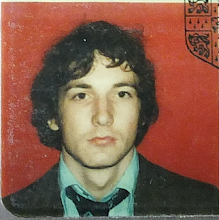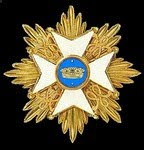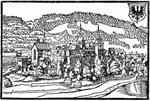Raised 1672 and commanded by Hans Willem Bentinck, Earl of Portland; often called Lord Portland's Horse in English accounts. At least 6 troops strong and possibly 9 so a very strong unit. Uniform was a blue coat with blue facings and sleeves often worn loose. Lace was gold. The hat was buff laced gold. The horses were black with red housings and holster caps laced gold.
The Windsor Great Wardrobe Accounts describe the standards as "blue Genoa damask" fringed gold and silver.
In English service 1688-1699
Actions:
1688: Landed Torbay 5th November at a strength of 3 squadrons (6 troops) for a total of 480 men
1690: Battle of the Boyne 2 squadrons strong; sieges of Cork and Kinsale
1691: Battle of Aughrim; 2 squadrons strong and suffered 29 casualties
War of the Spanish Succession:
1706; Battle of Ramillies
1708: Battle of Oudenarde
1709: Battle of Malplaquet
The standards were carried with William's cipher from 1696 after the death of Queen Mary. We do not know if the same standards were carried in the WSS but, given the longevity of expensive and high quality cavalry standards, it is possible - and we have no evidence otherwise...



















Another extremely handsome standard, David! It brings on more of those ever dangerous butterflies. Oh, to have four arms, two sets of eyes, and 48-hour days. A bottomless warchest would help too.
ReplyDeleteKind Regards,
Stokes
Thank you, Stokes. :-) I do agree - if I could clone myself I could have one of me doing flags non-stop, another sorting out my wargames armies, one doing environmental campaigning, and perhaps one relaxing and not doing much at all! ;-)
DeleteAll the best,
David.
More Dutch loveliness David, such a rich blue, it is very nice.
ReplyDeleteThank you, Donnie. The Dutch flags are certainly worth the work, I think, although some of the flags are a lot of eye-scrunching work to achieve...
DeleteAll the best,
David.
Ohhh that's a nice flag.
ReplyDeleteWillz.
Thank you, Willz. :-) More Dutch flags on the way soon...
DeleteAll the best,
David.
Beautiful, but I'm not sure how durable the damask would be on campaign, but I suppose it was rarely unfurled...
ReplyDeleteThank you, Steve. :-) Beacuse of the quality of the materials (stitched, embroidered, multiple layers etc.) cavalry standards survive much more often than infantry flags - that's also partly explained by the way cavalry can skedaddle faster out of trouble than infantrymen!
DeleteAll the best,
David.
Another beauty!
ReplyDeleteThank you, Ray. :-) I do like damask patterns, although too often we do not know the exact patterns used, probably becasue there was no standardisation...
DeleteAll the best,
David.!
OK, that does it! I will, later this year, start a Dutch WAS army for Fontenoy but with WSS flags. They may have been a tad dull with the predominance of grey uniforms, but fantastic flags!
ReplyDeleteThanks! I'm glad to inspire. I plan to do Dutch flags of the WAS at some point; we know there are a fair number depicted in the Triomphes Louis XV. I have just discovered a Dan Schorr article from the Courier magazine, all now online, that identifies many of them so will be using that to help me: you can find it here: https://stefanov.no-ip.org/MagWeb/courier/63/tc63dutc.htm
DeleteAll the best,
David.